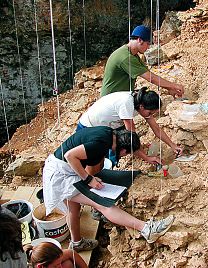Students dig into program that explores human originsBy Eric Quiñones Princeton NJ -- When anthropologist Alan Mann came to Princeton from the University of Pennsylvania two years ago, he brought with him a program that allows students to explore the evolution of humankind while enjoying the beauty of a summer in France.
The Princeton in Bordeaux program takes about 15 students on a journey to southwestern France for a course titled "Human Origins," which consists of three weeks of lectures at the University of Bordeaux and three weeks of field work at a Neanderthal excavation site in the small country town of Marillac. Students from a wide range of concentrations have enrolled in the program to gain a better understanding of the links between modern humans and their ancestors. "We examine the question of what constitutes a human, what makes us unique, and the context in which this special quality developed," Mann said. "It's really quite an extraordinary interaction for many of the students in terms of learning about human origins and deciding for themselves -- as an English major or as a computer science major -- just exactly what is a human." "The opportunity to have actual field experience was definitely a draw, and it's something that's not an option for the vast majority of courses," said Kathleen Brennan, a junior concentrating in cultural anthropology, who participated this past summer. "Being at the dig site was amazing and provided an incredible opportunity to learn about field work techniques and the dynamics of a site. This definitely wouldn't have been possible from just lectures and a course reader."
Mann developed the summer program in 1991 at Penn after spending 15 months doing research at the University of Bordeaux, where he continues to hold a joint appointment as a researcher. A visiting lecturer at Princeton for many years, he joined the University's Department of Anthropology faculty full time in fall 2001. At Princeton he teaches courses on human evolution and adaptation, as well as a freshman seminar on evolutionary anthropology. In structuring the summer course, Mann has emphasized a cross-disciplinary approach to the study of human origins by including lectures from anthropologists, archaeologists, paleontologists and geologists from Europe and the United States. Both in the classroom and in the field, students learn about the development of humans' physical form and symbolic representations such as art and language. In addition to completing mid-term and final exams, students are required to submit a field notebook detailing their experiences. For the field work portion of the course, the group stays in a priory adjacent to a 12th-century church in Marillac, dines among the local residents and participates in the excavation of a site once home to the Neanderthals, who lived between 30,000 and 150,000 years ago. The site work helps build an understanding of the development of stone tools, the identification and analysis of animal bones and other aspects of the dig. "We were directly exposed to the work done on an excavation. We didn't just help clean up or do menial work, we did it all," said Ayana Harry, a junior majoring in art and archaeology.
The group last summer uncovered bones of reindeer, hyena, birds and small mammals, as well as Neanderthal teeth that showed evidence they had been digested by scavenging hyenas. "This gives an indication of the harshness of the environment," Mann said. On the last day, sophomore David Bartels found a portion of a Neanderthal skull, a rare discovery, and the group barely missed hitting upon an even more significant find. "Just after we left, a group of French students came up with a beautiful set of Neanderthal bones in an area where we had not finished," Mann recalled. In addition to the excavation, the second half of the course includes excursions to study prehistoric cave art. Ari Samsky, a member of Princeton's class of 2003 who is now a graduate student in the anthropology department, attended Princeton in Bordeaux as a student in 2002 and as an assistant to Mann this past summer. He said the highlight was a trip in 2002 to a cave called Rouffignac, which required a drive of several hours from Marillac and a trolley ride into the deepest part of the cave. "Over our heads, close enough to touch, were hundreds of beautiful, expressive line drawings of animals," Samsky said. "The cave art was completely overwhelming in person -- nothing like seeing it in reproduction. The animals were incredibly, vibrantly detailed, down to their facial expressions, and we could tell that the artists had studied them intensely." Another key anthropological facet of the course is observing and participating in the culture of the French countryside where the students live and work. "We became part of the town and lives of the people there -- going to work at the site every day and walking back to the house discussing what we had uncovered, or not uncovered, that morning," said Dena Rothstein, a junior majoring in art history. "We made friends with the townspeople and got a sincere understanding for the complexities of the dig site, which first looked like a huge pit of dirt upon our arrival." In discussing the first two summers of Princeton in Bordeaux -- and looking forward to the third and beyond -- Mann exudes a palpable enthusiasm for learning and living with his students in such a picturesque setting far from campus. For students, the bonding experience has been equally strong. "There was a great dynamic that we brought with us to the site," Brennan said. "I was really thankful that I got to work with such a quirky, funny and amazing group of students." Mann is accepting applications for the next summer's Princeton in Bordeaux program until March 15, 2004. He can be reached via e-mail at [mann@princeton.edu]. For more information about the program, visit [www.princeton.edu/~mann/ Princeton_in_Bordeaux.shtml]. |
Contents |
|||||||||||||
| top
|



